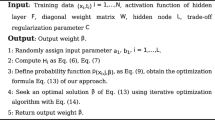Abstract
The original extreme learning machine (ELM) was designed for the balanced data, and it balanced misclassification cost of every sample to get the solution. Weighted extreme learning machine assumed that the balance can be achieved through the equality of misclassification costs. This paper improves previous weighted ELM with decay-weight matrix setting for balance and optimization learning. The decay-weight matrix is based on the sample number of each class, but the weight sum values of each class are not necessarily equal. When the number of samples is reduced, the weight sum is also reduced. By adjusting the decaying velocity, classifier could achieve more appropriate boundary position. From the experimental results, the decay-weighted ELM obtains the better effects in solving the imbalance classification tasks, particularly in multiclass tasks. This method was successfully applied to build the prediction model in the urban traffic congestion prediction system.










Similar content being viewed by others
References
Huang, G.B., Zhu, Q.Y., Siew, C.K.: Extreme learning machine: theory and applications. Neurocomputing 70(1–3), 489–501 (2006)
Huang, G.B., Chen, L., Siew, C.K.: Universal approximation using incremental constructive feedforward networks with random hidden nodes. IEEE Trans. Neural Netw. 17(4), 879–892 (2006)
Huang, G.B., Chen, L.: Convex incremental extreme learning machine. Neurocomputing 70(16–18), 3056–3062 (2007)
Huang, G.B., Chen, L.: Enhanced random search based incremental extreme learning machine. Neurocomputing 71(16–18), 3460–3468 (2008)
Huang, G.B., Ding, X., Zhou, H.: Optimization method based extreme learning machine for classification. Neurocomputing 74(1–3), 155–163 (2010)
Huang, G.B., Zhou, H., Ding, X., et al.: Extreme learning machine for regression and multiclass classification. IEEE Trans. Syst. Man. Cybern. B Cybern. A Publ. IEEE Syst. Man Cybern. Soc. 42(42), 513–529 (2012)
Zhong, H., Miao, C., Shen, Z., et al.: Comparing the learning effectiveness of BP, ELM, I-ELM, and SVM for corporate credit ratings. Neurocomputing 128(5), 285–295 (2014)
Huang, G., Song, S., Gupta, J.N., et al.: Semi-supervised and unsupervised extreme learning machines. IEEE Trans. Cybern. 44(12), 2405–2417 (2014)
Wang, P., Wang, D., Feng, W.: Online semi-supervised extreme learning machine based on manifold regularization[J]. J. Shanghai Jiaotong Univ. (Sci.) 49(08), 1153–1158 (2015)
Wang, W., Zhang, R.: Improved Convex Incremental Extreme Learning Machine Based on Enhanced Random Search. Unifying Electrical Engineering and Electronics Engineering, pp. 2033–2040. Springer, New York (2014)
Hai-Feng, K.E., Ying, J.: Real-time license character recognition technology based on R-ELM. J. Zhejiang Univ. 48(2), 1209–1216 (2014)
Stolfo, S. J., Fan, W., Lee, W., et al.: Cost-based modeling for fraud and intrusion detection: results from the JAM project. In: DARPA Information Survivability Conference and Exposition, 2000. DISCEX ’00. Proceedings. IEEE Xplore, vol. 2, pp. 130–144 (2000)
Strack, B., Deshazo, J.P., Gennings, C., et al.: Impact of HbA1c measurement on hospital readmission rates: analysis of 70,000 clinical database patient records.[J]. Biomed. Res. Int. 2014(6), 781670 (2014)
He, H., Garcia, E.A.: Learning from imbalanced data. IEEE Trans. Knowl. Data Eng. 21(9), 1263–1284 (2009)
Akbani, R., Kwek, S., Japkowicz, N.: Applying support vector machines to imbalanced datasets. Lecture Notes in Computer Science 3201, 39–50 (2004)
Liu, X.Y., Wu, J., Zhou, Z.H.: Exploratory undersampling for class-imbalance learning. IEEE Trans. Syst. Cybern. B Cybern. A Publ. IEEE Syst. Man Cybern. Soc. 39(2), 539–550 (2009)
Chawla, N.V., Lazarevic, A., Hall, L.O., et al.: SMOTEBoost: improving prediction of the minority class in boosting. Lecture Notes in Computer Science 2838, 107–119 (2003)
Deng, W., Zheng, Q., Regularized, Chen L.: Learning, extreme, machine[C], computational intelligence and data mining, : CIDM ’09. IEEE Symposium on. IEEE Xplore 2009, 389–395 (2009)
Zong, W., Huang, G.B., Chen, Y.: Weighted extreme learning machine for imbalance learning. Neurocomputing 101(3), 229–242 (2013)
Fletcher, R.: Practical Methods of Optimization: Constrained Optimization. Practical Methods of Optimization, pp. 71–94. John Wiley, Hoboken (1981)
Lichman, M.: UCI Machine Learning Repository [http://archive.ics.uci.edu/ml]. Irvine, CA: University of California, School of Information and Computer Science (2013)
Acknowledgements
This work was supported by National Nature Science Foundation of P. R. China (No. 61272357, 61300074) and National Key Research and Development Program of China (No. 2016YFB0700502, 2016YFB1001404).
Author information
Authors and Affiliations
Corresponding authors
Rights and permissions
About this article
Cite this article
Shen, Q., Ban, X., Liu, R. et al. Decay-weighted extreme learning machine for balance and optimization learning. Machine Vision and Applications 28, 743–753 (2017). https://doi.org/10.1007/s00138-017-0828-4
Received:
Revised:
Accepted:
Published:
Issue Date:
DOI: https://doi.org/10.1007/s00138-017-0828-4




